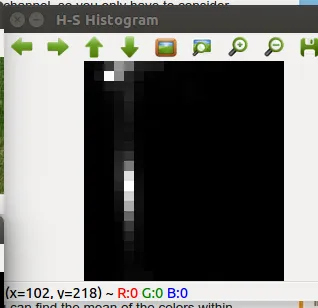我想找到图片中的主要颜色。为此,我知道应该使用图片直方图。但我不确定图片格式。RGB、HSV还是灰度图片,哪一种应该使用?
计算出直方图后,我应该在直方图上找到最大值。对于HSV图像,我是否应该找到低于最大binVal值的值?为什么我的结果图片只包含黑色?
float binVal = hist.at<float>(h, s);
编辑:
我尝试了下面的代码。我绘制了h-s直方图。我的结果图像在这里。在二值阈值之后,我没有发现任何东西。也许我错误地找到最大直方图值。


cvtColor(src, hsv, CV_BGR2HSV);
// Quantize the hue to 30 levels
// and the saturation to 32 levels
int hbins = 20, sbins = 22;
int histSize[] = {hbins, sbins};
// hue varies from 0 to 179, see cvtColor
float hranges[] = { 0, 180 };
// saturation varies from 0 (black-gray-white) to
// 255 (pure spectrum color)
float sranges[] = { 0, 256 };
const float* ranges[] = { hranges, sranges };
MatND hist;
// we compute the histogram from the 0-th and 1-st channels
int channels[] = {0, 1};
calcHist( &hsv, 1, channels, Mat(), // do not use mask
hist, 2, histSize, ranges,
true, // the histogram is uniform
false );
double maxVal=0;
minMaxLoc(hist, 0, &maxVal, 0, 0);
int scale = 10;
Mat histImg = Mat::zeros(sbins*scale, hbins*10, CV_8UC3);
int maxIntensity = -100;
for( int h = 0; h < hbins; h++ ) {
for( int s = 0; s < sbins; s++ )
{
float binVal = hist.at<float>(h, s);
int intensity = cvRound(binVal*255/maxVal);
rectangle( histImg, Point(h*scale, s*scale),
Point( (h+1)*scale - 1, (s+1)*scale - 1),
Scalar::all(intensity),
CV_FILLED );
if(intensity > maxIntensity)
maxIntensity = intensity;
}
}
std::cout << "max Intensity " << maxVal << std::endl;
Mat dst;
cv::threshold(src, dst, maxIntensity, 255, cv::THRESH_BINARY);
namedWindow( "Dest", 1 );
imshow( "Dest", dst );
namedWindow( "Source", 1 );
imshow( "Source", src );
namedWindow( "H-S Histogram", 1 );
imshow( "H-S Histogram", histImg );



